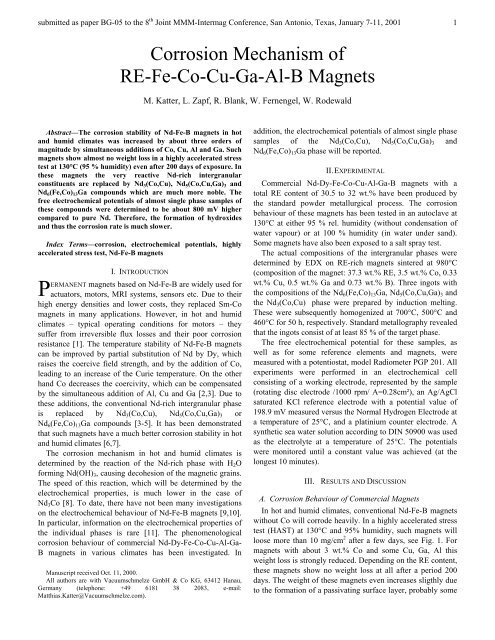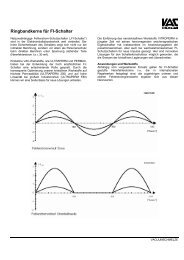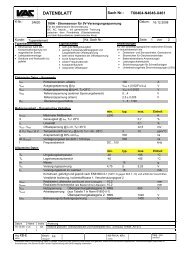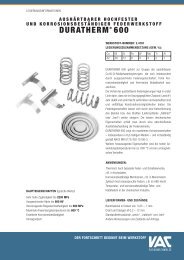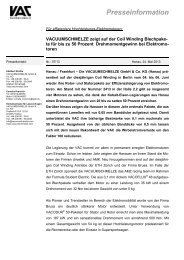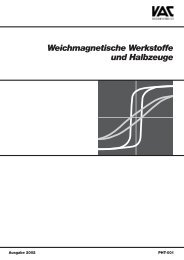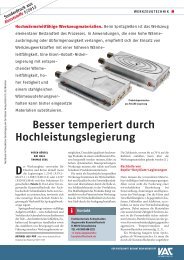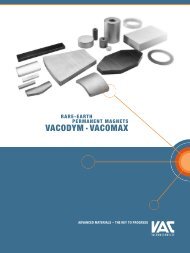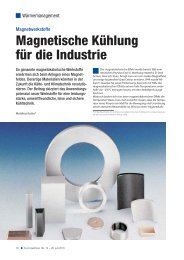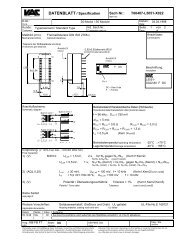Download - VACUUMSCHMELZE GmbH & Co. KG
Download - VACUUMSCHMELZE GmbH & Co. KG
Download - VACUUMSCHMELZE GmbH & Co. KG
You also want an ePaper? Increase the reach of your titles
YUMPU automatically turns print PDFs into web optimized ePapers that Google loves.
submitted as paper BG-05 to the 8 th Joint MMM-Intermag <strong>Co</strong>nference, San Antonio, Texas, January 7-11, 2001 1<br />
<strong>Co</strong>rrosion Mechanism of<br />
RE-Fe-<strong>Co</strong>-Cu-Ga-Al-B Magnets<br />
Abstract—The corrosion stability of Nd-Fe-B magnets in hot<br />
and humid climates was increased by about three orders of<br />
magnitude by simultaneous additions of <strong>Co</strong>, Cu, Al and Ga. Such<br />
magnets show almost no weight loss in a highly accelerated stress<br />
test at 130°C (95 % humidity) even after 200 days of exposure. In<br />
these magnets the very reactive Nd-rich intergranular<br />
constituents are replaced by Nd 3(<strong>Co</strong>,Cu), Nd 5(<strong>Co</strong>,Cu,Ga) 3 and<br />
Nd 6(Fe,<strong>Co</strong>) 13Ga compounds which are much more noble. The<br />
free electrochemical potentials of almost single phase samples of<br />
these compounds were determined to be about 800 mV higher<br />
compared to pure Nd. Therefore, the formation of hydroxides<br />
and thus the corrosion rate is much slower.<br />
Index Terms—corrosion, electrochemical potentials, highly<br />
accelerated stress test, Nd-Fe-B magnets<br />
P<br />
I. INTRODUCTION<br />
ERMANENT magnets based on Nd-Fe-B are widely used for<br />
actuators, motors, MRI systems, sensors etc. Due to their<br />
high energy densities and lower costs, they replaced Sm-<strong>Co</strong><br />
magnets in many applications. However, in hot and humid<br />
climates – typical operating conditions for motors – they<br />
suffer from irreversible flux losses and their poor corrosion<br />
resistance [1]. The temperature stability of Nd-Fe-B magnets<br />
can be improved by partial substitution of Nd by Dy, which<br />
raises the coercive field strength, and by the addition of <strong>Co</strong>,<br />
leading to an increase of the Curie temperature. On the other<br />
hand <strong>Co</strong> decreases the coercivity, which can be compensated<br />
by the simultaneous addition of Al, Cu and Ga [2,3]. Due to<br />
these additions, the conventional Nd-rich intergranular phase<br />
is replaced by Nd3(<strong>Co</strong>,Cu), Nd5(<strong>Co</strong>,Cu,Ga)3 or<br />
Nd6(Fe,<strong>Co</strong>)13Ga compounds [3-5]. It has been demonstrated<br />
that such magnets have a much better corrosion stability in hot<br />
and humid climates [6,7].<br />
The corrosion mechanism in hot and humid climates is<br />
determined by the reaction of the Nd-rich phase with H2O<br />
forming Nd(OH)3, causing decohesion of the magnetic grains.<br />
The speed of this reaction, which will be determined by the<br />
electrochemical properties, is much lower in the case of<br />
Nd3<strong>Co</strong> [8]. To date, there have not been many investigations<br />
on the electrochemical behaviour of Nd-Fe-B magnets [9,10].<br />
In particular, information on the electrochemical properties of<br />
the individual phases is rare [11]. The phenomenological<br />
corrosion behaviour of commercial Nd-Dy-Fe-<strong>Co</strong>-Cu-Al-Ga-<br />
B magnets in various climates has been investigated. In<br />
Manuscript received Oct. 11, 2000.<br />
All authors are with Vacuumschmelze <strong>GmbH</strong> & <strong>Co</strong> <strong>KG</strong>, 63412 Hanau,<br />
Germany (telephone: +49 6181 38 2083, e-mail:<br />
Matthias.Katter@Vacuumschmelze.com).<br />
M. Katter, L. Zapf, R. Blank, W. Fernengel, W. Rodewald<br />
addition, the electrochemical potentials of almost single phase<br />
samples of the Nd3(<strong>Co</strong>,Cu),<br />
Nd5(<strong>Co</strong>,Cu,Ga)3 and<br />
Nd6(Fe,<strong>Co</strong>)13Ga phase will be reported.<br />
II. EXPERIMENTAL<br />
<strong>Co</strong>mmercial Nd-Dy-Fe-<strong>Co</strong>-Cu-Al-Ga-B magnets with a<br />
total RE content of 30.5 to 32 wt.% have been produced by<br />
the standard powder metallurgical process. The corrosion<br />
behaviour of these magnets has been tested in an autoclave at<br />
130°C at either 95 % rel. humidity (without condensation of<br />
water vapour) or at 100 % humidity (in water under sand).<br />
Some magnets have also been exposed to a salt spray test.<br />
The actual compositions of the intergranular phases were<br />
determined by EDX on RE-rich magnets sintered at 980°C<br />
(composition of the magnet: 37.3 wt.% RE, 3.5 wt.% <strong>Co</strong>, 0.33<br />
wt.% Cu, 0.5 wt.% Ga and 0.73 wt.% B). Three ingots with<br />
the compositions of the Nd6(Fe,<strong>Co</strong>)13Ga, Nd5(<strong>Co</strong>,Cu,Ga)3 and<br />
the Nd3(<strong>Co</strong>,Cu) phase were prepared by induction melting.<br />
These were subsequently homogenized at 700°C, 500°C and<br />
460°C for 50 h, respectively. Standard metallography revealed<br />
that the ingots consist of at least 85 % of the target phase.<br />
The free electrochemical potential for these samples, as<br />
well as for some reference elements and magnets, were<br />
measured with a potentiostat, model Radiometer PGP 201. All<br />
experiments were performed in an electrochemical cell<br />
consisting of a working electrode, represented by the sample<br />
(rotating disc electrode /1000 rpm/ A=0.28cm²), an Ag/AgCl<br />
saturated KCl reference electrode with a potential value of<br />
198.9 mV measured versus the Normal Hydrogen Electrode at<br />
a temperature of 25°C, and a platinium counter electrode. A<br />
synthetic sea water solution according to DIN 50900 was used<br />
as the electrolyte at a temperature of 25°C. The potentials<br />
were monitored until a constant value was achieved (at the<br />
longest 10 minutes).<br />
III. RESULTS AND DISCUSSION<br />
A. <strong>Co</strong>rrosion Behaviour of <strong>Co</strong>mmercial Magnets<br />
In hot and humid climates, conventional Nd-Fe-B magnets<br />
without <strong>Co</strong> will corrode heavily. In a highly accelerated stress<br />
test (HAST) at 130°C and 95% humidity, such magnets will<br />
loose more than 10 mg/cm 2 after a few days, see Fig. 1. For<br />
magnets with about 3 wt.% <strong>Co</strong> and some Cu, Ga, Al this<br />
weight loss is strongly reduced. Depending on the RE content,<br />
these magnets show no weight loss at all after a period 200<br />
days. The weight of these magnets even increases sligthly due<br />
to the formation of a passivating surface layer, probably some
submitted as paper BG-05 to the 8 th Joint MMM-Intermag <strong>Co</strong>nference, San Antonio, Texas, January 3:1 7-11, 2001<br />
2<br />
2<br />
0<br />
-2<br />
-4<br />
-6<br />
-8<br />
RE = 32 wt.%<br />
no <strong>Co</strong><br />
RE = 30.8 wt. %<br />
<strong>Co</strong> = 3.1 %<br />
RE = 31.3 wt.%<br />
<strong>Co</strong> = 3.1 wt.%<br />
-10<br />
Fig. 1..Weight change of RE-Fe-<strong>Co</strong>-Cu-Ga-Al-B magnets in a HAST test<br />
(130°C, 95<br />
0<br />
% humidity, no<br />
50<br />
condensation of<br />
100<br />
water vapour)<br />
150 200<br />
exposure time (days)<br />
(Nd,Fe)-hydroxides, s. Fig. 1.<br />
The corrosion sequence of uncoated RE-Fe-<strong>Co</strong>-Cu-Al-Ga-<br />
B magnets under HAST conditions (no dew) is the following:<br />
After some days, a few small chips (50 – 200 µm) will break off from sharp<br />
edges.<br />
1. Simultaniously, small, partly removeable stains consisting<br />
of RE-rich platelets appear (diameter up to 10 µm,<br />
thickness a few µm), there is no substantial weight loss<br />
during this period.<br />
2. After 40 – 200 days, material in form of loose powder is<br />
lost, initially from the edges.<br />
The corrosion rate is accelerated by a factor of about 10 by<br />
performing the stress test at 130°C and a humidty of 100 %<br />
allowing condensation of water (pressure cooker test). But the<br />
sequence is the same as without condensation: after an<br />
incubation time of about 10 days with slight weight increase,<br />
the material loss again starts at the edges of the magnet. Under<br />
salt spray conditions according to DIN 50021 all investigated<br />
magnets are covered with red rust after 24 h, independent of<br />
wether they contain <strong>Co</strong> or not. Under such environments <strong>Co</strong>containing<br />
magnets must be coated as well. The corrosion<br />
behaviour is similar to pure Fe.<br />
B. Electrochemical Potentials and <strong>Co</strong>rrosion Mechanism<br />
For a certain range of composition, the intergranular<br />
constitutents of Nd-Dy-Fe-<strong>Co</strong>-Cu-Al-Ga-B magnets are only<br />
Nd3(<strong>Co</strong>,Cu), Nd5(<strong>Co</strong>,Cu,Ga)3, Nd6(Fe,<strong>Co</strong>)13Ga and<br />
unavoidable impurites like RE oxides. In particular, no pure<br />
Nd and also no Nd1.1Fe4B4 or Nd2Fe17 is observed, see Fig. 2.<br />
Table 1 shows the electrochemical potentials of various Nd-<br />
Fe-B magnets, related compounds and of the most important<br />
corrosion protective coatings for this material (electronickel,<br />
IVD-aluminium) measured in reference to an Ag/AgClelectrode.<br />
The pure rare earth metals Nd, Pr, and Dy represent<br />
the intergranular phase (> 95 wt.% rare earth) in <strong>Co</strong>/Cu-free<br />
magnets. The three phases with <strong>Co</strong>, Cu and Ga are the<br />
intergranular phases in <strong>Co</strong>/Cu/Ga-containing materials.<br />
Magnets A, B and C represent the matrix phases of different<br />
magnet alloy types with and without <strong>Co</strong>,Cu and Ga.<br />
3:1<br />
5:3<br />
3:1<br />
3:1<br />
6:13:1<br />
Fig. 2. Microstructure of a Nd-Dy-Fe-<strong>Co</strong>-Cu-Al-Ga-B magnet with a RE<br />
content of 37.3 wt.%. The Nd3(<strong>Co</strong>,Cu), Nd5(<strong>Co</strong>,Cu,Ga)3 and the<br />
Nd6(Fe,<strong>Co</strong>)13Ga phases are denoted by 3:1, 5:3 and 6:13:1, respectively.<br />
TABLE I<br />
COMPOSITIONS AND ELECTROCHEMICAL POTENTIALS OF VARIOUS ND-FE-B<br />
MAGNETS AND RELATED COMPOUNDS MEASURED IN ARTIFICAL SEA WATER<br />
WITH RESPECT TO AN AG/AGCL SATURATED KCL REFERENCE ELECTRODE<br />
sample Nd Dy Fe <strong>Co</strong> Cu Ga potential<br />
(all elements in wt.%) (mV)<br />
magnet A 30 0.5 bal. / / / -730<br />
magnet B 24.5 8.5 bal. / / / -670<br />
magnet C 22 9 bal. 3 0.2 0.3 -700<br />
Nd 3(<strong>Co</strong>,Cu) bal. / 1.8 10.5 1.9 / -900<br />
Nd 5(<strong>Co</strong>,Cu,Ga) 3 bal. / 3.1 4.5 3.3 10.1 -807<br />
Nd 6(Fe,<strong>Co</strong>) 13Ga bal. 2.5 43.3 2.0 / 3.4 -750<br />
Pr -1689<br />
Nd -1670<br />
Dy -1645<br />
Al -720<br />
Ni -130<br />
The electrochemical potential difference between the<br />
individual phases of an alloy is the driving force for corrosion<br />
reactions. The bigger the potential difference between the<br />
matrix and the intergranular phase of a magnet the higher is<br />
the corrosion rate. In humid atmosphere, the following<br />
reactions (1) – (3) can occur with Nd-Fe-B magnets. These<br />
reactions result in a fast decomposition of the intergranular<br />
phase by attack of water vapour at higher temperatures (e.g.<br />
autoclave test at 130°C / 100 % humidity, 2.7 bar).<br />
2 Nd + 3 H2O � NdH3 + Nd(OH)3 (1)<br />
NdH3 + 3 H2O � Nd(OH)3 + 3 H2 (2)<br />
Nd + 3/2 H2 � NdH3 (3)<br />
Equation (1) and (2) demonstrate the reaction between the<br />
intergranular phase and water. The products of these reactions<br />
are Nd-hydroxide and Hydrogen which reacts according to<br />
equation (3) with the Nd-rich intergranular phase to form Ndhydride.<br />
Nd-hydride is not stable under these conditions and<br />
decomposes again to Nd-hydroxide and Hydrogen (2) and the<br />
whole sequence starts again. This means every water molecule<br />
which reacts with the intergranular phase accelerates the<br />
conversion of Neodymium to Nd-hydroxide. The effect of this<br />
conversion is a strong volume increase of the intergranular<br />
phase what results in cracks along the grainboundaries. A
submitted as paper BG-05 to the 8 th Joint MMM-Intermag <strong>Co</strong>nference, San Antonio, Texas, January 7-11, 2001 3<br />
complete decomposition to a magnet powder (”white<br />
corrosion”) occurs.<br />
The starting reaction (1) is controlled by the<br />
electrochemical potential of the intergranular phase. The<br />
matrix phase which is more noble does not react significantly<br />
with water under these conditions. Therefore, the way to avoid<br />
this type of corrosion is to shift the electrochemical potential<br />
of the intergranuler phase close to that of the matrix phase.<br />
This can be achieved by adding more noble metals to the<br />
intergranular phase, such as <strong>Co</strong> or Cu. By these additions, the<br />
electrochemical potential increases from about – 1600 mV to<br />
– 800 mV. The result is that the corrosion rate of the magnet<br />
material in the autoclave test decreases by a factor of 1000.<br />
Selective intergranular corrosion and powder decomposition is<br />
strongly slowed down. A similar behaviour is observed with<br />
coated magnets. The corrosion rates in all type of tests drop<br />
significantly.<br />
C. Magnetic Properties<br />
Additionally, the remanence as well as the coercivity of the<br />
new <strong>Co</strong>-containing magnets were increased compared to<br />
conventional sintered Nd-Fe-B magnets. Due to the cobalt<br />
content of about 3 wt.% and an optimized microstructure, the<br />
temperature coefficients of the remanence and of the<br />
coercivity were improved by about 20 % and 10 %,<br />
respectively. Tailoring the Dy-content, typical energy<br />
densities, remanences and coercivities from (BH)max = 44 – 28<br />
MGOe, Br = 1,35 – 1,08 T and HcJ = 18 – 33 kOe are achieved<br />
in mass production.<br />
IV. CONCLUSIONS<br />
The corrosion mechanism in hot and humid climates for<br />
conventional magnets as well as for magnets containing <strong>Co</strong>,<br />
Cu, Al and Ga is determined by the formation of Ndhydroxide<br />
and free hydrogen. The hydrogen embrittles the<br />
remaining intergranular phase and together with the volume<br />
expansion caused by the formation of the Nd-hydroxide,<br />
matrix grains will peel off.<br />
This reaction is much slower in magnets containing <strong>Co</strong>, Cu,<br />
Al and Ga. In these magnets the intergranular constituents<br />
consists of Nd3(<strong>Co</strong>,Cu), Nd5(<strong>Co</strong>,Cu,Ga)3 and Nd6(Fe,<strong>Co</strong>)13Ga<br />
compounds, all of them are much more noble compared to the<br />
pure Nd present in standard Nd-Fe-B magnets. Therefore the<br />
elcectrochemical driving force to form Nd-hydroxide is<br />
smaller in the new magnets, resulting in a reduction of the<br />
corrosion rate by a factor of about 1000.<br />
In water and particularly under salt spray conditions, the<br />
matrix grains themselves are attacked to form red rust. Here,<br />
the better corrosion stability of the intergranular constituents<br />
has no influence on the overall corrosionstability. Under such<br />
environments all Nd-Fe-B magnets must be coated<br />
irrespective of wether they contain <strong>Co</strong> or not.<br />
Besides the improved corrosion resistance, the magnetic<br />
properties were also enhancend, especially at elevated<br />
temperatures. Therefore, the new Nd-Fe-B magnets containing<br />
<strong>Co</strong>, Cu, Al and Ga are suited particularly for motor<br />
applications.<br />
ACKNOWLEDGMENT<br />
The authors greatly acknowledge microstructural<br />
investigations by P. Schrey and electrochemical measurements<br />
and corrosion tests which have been performed by G. Rodner.<br />
Many thanks for R. Mottram for proof-reading the manuscript.<br />
REFERENCES<br />
[1] A. S. Kim and F. E. Camp, ”High performance NdFeB magnets,” J.<br />
Appl. Phys. vol. 79, 1996, pp. 5035-5039.<br />
[2] T. Kajitani, K. Nagayama, and T. Umeda, ”Microstructure of Cu-added<br />
Pr-Fe-B magnets: crystallization of antiferromagnetic Pr6Fe13Cu in the<br />
boundary region,” J. Magn. Magn. Mat, vol. 117, 1992, p. 379-86.<br />
[3] M. Tokunaga, ”Magnetic properties and thermal stability of Nd-Fe-B<br />
sintered magnets and their microstructure,” Proc. of the MRS<br />
International Meeting on Advanced Materials, vol. 11, Mater. Res. Soc:<br />
Pittsburgh, 1989, p.53-67.<br />
[4] W. Fernengel, M. Velicescu, W. Rodewald, P. Schrey, and B. Wall,<br />
”Magnetic properties and microstructure of high-energy sintered<br />
(Nd,Dy)-(Fe,<strong>Co</strong>,Cu)-B magnets,” Proc. 3 rd ISPMM <strong>Co</strong>nference, Seoul,<br />
1995, p. 748.<br />
[5] K. Ohashi, Y. Tawara, T. Yokoyama, and N. Kobayashi, ”<strong>Co</strong>rrosion<br />
resistance of cobalt-containing Nd-Fe-<strong>Co</strong>-B magnets,” Proc. 9 th Int.<br />
Workshop on Rare Earth Magnets and their Applications, 1987, p. 355-<br />
61.<br />
[6] B. Grieb, ”New corrosion resistant materials based on neodym-ironboron,”<br />
IEEE Trans. Magn., vol. 33, 1997, p. 3904-6.<br />
[7] M. Katter, ”Sintered NdFeB magnets with improved temperature and<br />
corrosion stability,” The U.K. Magnetics Society, one-day seminar on<br />
Recent Advances in Permanent Magnets: Processing and Applications,<br />
6. Okt. 1999, University of Birmingham.<br />
[8] S. Hirosawa, S. Mino, and H. Tomizawa, ”Improved corrosion resistance<br />
and magnetic properties of Nd-Fe-B-type sintered magnets with Mo and<br />
<strong>Co</strong>,” J. Appl. Phys., vol. 69, 1991, p 5844-6.<br />
[9] G.W. Warren, G. Gao, and Q. Li, ”<strong>Co</strong>rrosion of NdFeB permanent<br />
magnet materials,” J. Appl. Phys., vol. 70, 1991, p. 6609-11.<br />
[10] A. M. El-Aziz, G. Barkleit, M. Herrich, K. Mummert, L. Schultz, and B.<br />
Grieb, ”<strong>Co</strong>rrosion behaviour of Nd-Fe-B permanent magnetic alloys,”<br />
Proc. 15 th Intern. Workshop on Rare Earth Magnets and their<br />
Applications, 1998, p. 905-13.<br />
[11] K. Mummert, A.M. El-Aziz, G. Barkleit, W. Rodewald, and L. Schultz,<br />
”<strong>Co</strong>rrosion behaviour of Nd-Fe-B permanent magnets,” Materials and<br />
<strong>Co</strong>rrosion, vol. 51, 2000, p. 13-19.


